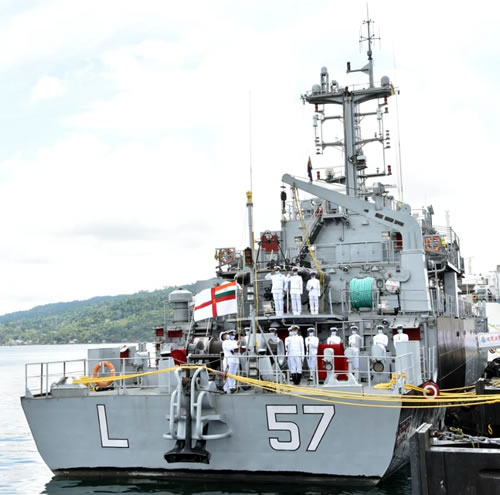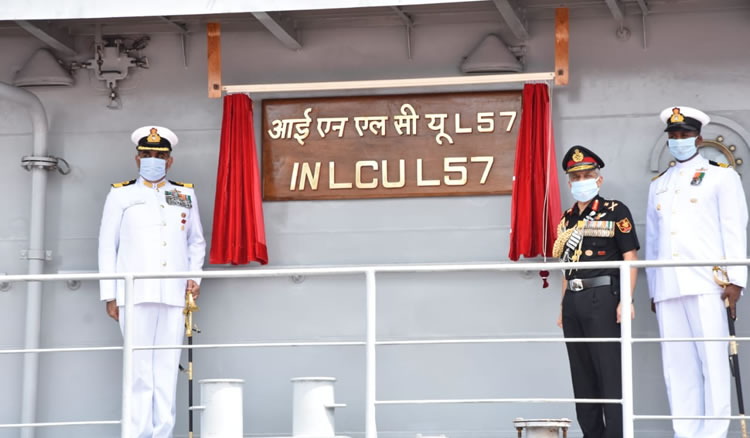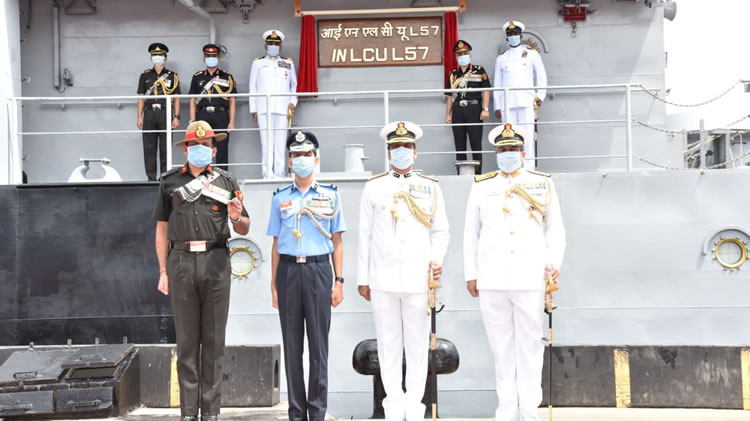INDIAN ARMED FORCES CHIEFS ON
OUR RELENTLESS AND FOCUSED PUBLISHING EFFORTS

SP Guide Publications puts forth a well compiled articulation of issues, pursuits and accomplishments of the Indian Army, over the years

I am confident that SP Guide Publications would continue to inform, inspire and influence.

My compliments to SP Guide Publications for informative and credible reportage on contemporary aerospace issues over the past six decades.
- Prime Minister witnesses 'Bharat Shakti' – a Tri-Services Firing and Manoeuvre Exercise in Pokhran, Rajasthan
- Interim Defence Budget 2024-25 — An Analysis
- Union Defence budget 2024
- Prime Minister Modi Commemorates Indian Navy Day in a Grand Ceremony
- Prime Minister Modi Flies in the LCA Tejas
- New Chapter in India-Italy Defence Ties
- Airpower beyond Boundaries
New Amphibious Warfare Craft Commissioned
 |
The Author is Former Director General of Information Systems and A Special Forces Veteran, Indian Army |

On May 15, 2020, INLCU-75 another amphibious warfare landing craft entered the Indian Navy at an official ceremony at Port Blair. The Landing Craft Utility (LCU) Mk-IV class vessel was commissioned by Commander-in-Chief Lieutenant General P.S. Rajeshwar. This is the seventh LCU Mk-IV that has entered the Indian Navy. The vessel has been indigenously designed and built by the Kolkata-headquarters Garden Research Shipbuilders and Engineers (GRSE). The LCU can carry up to 216 personnel and 145 tonnes of cargo and is fitted with a hydraulic bow ramp.
GRSE was founded in 1884 as a small privately owned company and renamed as Garden Reach Workshop in 1916. It was nationalised in 1960 as GRSE and awarded Mini-Ratna status in 2006. It is the first Indian shipyard to build 100 warships and vessels including guided-missile frigates, corvettes, fleet tankers, fast patrol vessels, amphibious warfare vessels and hovercraft. Among commercial vessels, GRSE builds oceanographic and hydrographic research ships, marine acoustic research ships, non-propelled dredgers, grab hopper dredgers, trailing suction hopper dredgers, tugboats and bulk carriers. A GRSE-built corvette was exported to Mauritius in 2014. It is also shortlisted for building patrol boats for Vietnam and is lowest bidder in building two light frigates for Philippines. GRSE had signed an agreement with the Indian Navy for designing and building eight LCU ships on September 28, 2011 at a cost of Rs 21 billion, following which construction began in September 2012. The INLCU-75 is seventh in the series LCU Mk-IV inducted into the Indian Navy. The eighth and the last LCU Ml-IV built by GRSE is likely to be delivered by end of the year. The LCU Mk-IV vessel is 62.8 metres long (206 feet) with an overall beam of 11 metres (36 feet) and a hull draught of 2.2 metres (7.2 feet). It displaces around 830 tonnes. The vessel is powered by two MTU 16V 4000 M53 marine diesel engines, each 1840 KW (2,470 hp), power the LCU. The vessel is equipped with two 30mm CRN-91 mounted guns with a Bharat Electronics-built EON-51 electro-optic director.

INLCU-75, commanded by Lieutenant Commander Harshvardhan Venugopal, has a complement of five officers, 45 sailors and is capable of carrying 160 troops. With the displacement of 830 tonnes, INLCU-75 can transport various kinds of combat equipment like the Main Battle Tanks Arjun and T-72 armoured fighting vehicles (AFVs) and other vehicles. The ship is fitted with state-of-art equipment and advanced systems, like Integrated Bridge System (IBS) and Integrated Platform Management System (IPMS). The LCU’s designated primary role is of transporting and deploying tanks, armoured vehicles, troops and equipment from ship to the shore. Based at the Andaman and Nicobar Command, these ships can be deployed for multirole activities like beaching operations, search and rescue, disaster relief operations, supply and replenishment and evacuation from distant islands. China has consolidated its position in the South China Sea and its integrated strategy of economic development and military expansion has enabled Beijing’s rapid expansion in the Indian Ocean Region (IOR). Frequency of Chinese nuclear submarines, warships, survey and spy vehicles, and dual-tasked fishing vehicles in the Indian Ocean has increased considerably. China having secured Hambantota Port in Sri Lanka for 99 years and Gwadar in Pakistan for 49 years, China is engaged in developing ports or bases in Jiwani (Pakistan), Maldives, Myanmar and Bangladesh.

As part of its growing strategic lift capabilities at sea, in 2019 China launched the Type 075 vessel – its largest amphibious ship that carries 900 marines, landing crafts, amphibious assault vehicles, 30 helicopters and can also house fighter jets. Two more Type 075 under construction would be ready by end of 2020. In March 2017, China announced increasing its marine corps from 20,000 to 100,000 for overseas tasks (mentioning Djibouti and Gwadar), plus increasing PLAN’s strength by 15 per cent from the existing 2,35,000. Chinese overseas projects usually have covert PLA presence, as would Hambantota Port and Colombo South Container Terminal (CSCT). There is speculation that China’s Marine Expeditionary Units (MEUs) will be operational in the Indian Ocean within five years. Djibouti and Pakistan would be MEU bases for sure but mobile MEUs patrolling the seas could berth at Sri Lanka, Bangladesh, and Myanmar on the pretext of rest, recoup and repairs. China has been conducting naval exercises with Pakistan Navy periodically and the unholy nexus between these two countries is visibly anti-India. The LCUs Mk-IV are part of combat capacity building of the India Navy, who are closely monitoring developments in the region.





